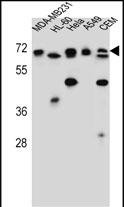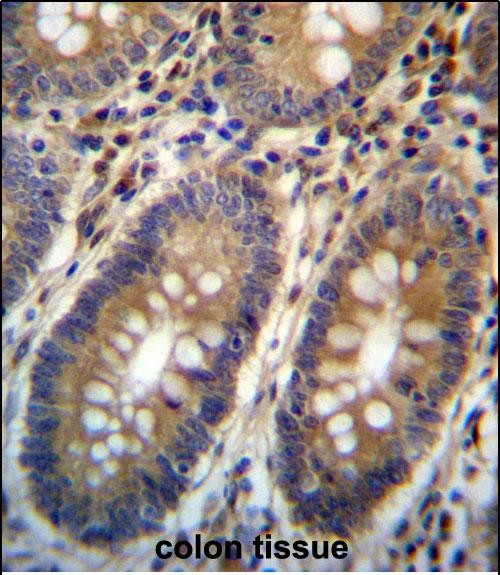ASMTL Antibody (Center)
Affinity Purified Rabbit Polyclonal Antibody (Pab)
- SPECIFICATION
- CITATIONS
- PROTOCOLS
- BACKGROUND

Application
| IHC-P, WB, E |
|---|---|
| Primary Accession | O95671 |
| Other Accession | NP_001166945.1, NP_004183.2 |
| Reactivity | Human |
| Host | Rabbit |
| Clonality | Polyclonal |
| Isotype | Rabbit IgG |
| Calculated MW | 68857 Da |
| Antigen Region | 231-259 aa |
| Gene ID | 8623 |
|---|---|
| Other Names | N-acetylserotonin O-methyltransferase-like protein, ASMTL, 211-, ASMTL |
| Target/Specificity | This ASMTL antibody is generated from rabbits immunized with a KLH conjugated synthetic peptide between 231-259 amino acids from the Central region of human ASMTL. |
| Dilution | IHC-P~~1:10~50 WB~~1:1000 E~~Use at an assay dependent concentration. |
| Format | Purified polyclonal antibody supplied in PBS with 0.09% (W/V) sodium azide. This antibody is purified through a protein A column, followed by peptide affinity purification. |
| Storage | Maintain refrigerated at 2-8°C for up to 2 weeks. For long term storage store at -20°C in small aliquots to prevent freeze-thaw cycles. |
| Precautions | ASMTL Antibody (Center) is for research use only and not for use in diagnostic or therapeutic procedures. |
| Name | ASMTL |
|---|---|
| Function | Nucleoside triphosphate pyrophosphatase that hydrolyzes dTTP and UTP. Can also hydrolyze CTP and the modified nucleotides pseudo- UTP, 5-methyl-UTP (m(5)UTP) and 5-methyl-CTP (m(5)CTP). Has weak activity with dCTP, 8-oxo-GTP and N(4)-methyl-dCTP (PubMed:24210219). May have a dual role in cell division arrest and in preventing the incorporation of modified nucleotides into cellular nucleic acids (PubMed:24210219). In addition, the presence of the putative catalytic domain of S-adenosyl-L-methionine binding in the C-terminal region argues for a methyltransferase activity (Probable). |
| Tissue Location | Widely expressed. In adult, highly expressed in pancreas, placenta, fibroblast, thymus, prostate, testis, ovary and colon. Expressed at lower levels in spleen, small intestine and leukocytes. In fetus, expressed at high levels in the lung and kidney and at lower level in brain and liver |

Thousands of laboratories across the world have published research that depended on the performance of antibodies from Abcepta to advance their research. Check out links to articles that cite our products in major peer-reviewed journals, organized by research category.
info@abcepta.com, and receive a free "I Love Antibodies" mug.
Provided below are standard protocols that you may find useful for product applications.
Background
The protein encoded by this gene has an N-terminus that is similar to the multicopy associated filamentation (maf) protein of Bacillus subtilis and to orfE of Escherichia coli, while the C-terminus is similar to N-acetylserotonin O-methyltransferase. This gene is located in the pseudoautosomal region 1 (PAR1) of X and Y chromosomes. Three transcript variants encoding different isoforms have been found for this gene.
References
Olsen, J.V., et al. Cell 127(3):635-648(2006)
Olsen, J.V., et al. Cell 127(3):635-648(2006)
Ried, K., et al. Hum. Mol. Genet. 7(11):1771-1778(1998)
If you have used an Abcepta product and would like to share how it has performed, please click on the "Submit Review" button and provide the requested information. Our staff will examine and post your review and contact you if needed.
If you have any additional inquiries please email technical services at tech@abcepta.com.













 Foundational characteristics of cancer include proliferation, angiogenesis, migration, evasion of apoptosis, and cellular immortality. Find key markers for these cellular processes and antibodies to detect them.
Foundational characteristics of cancer include proliferation, angiogenesis, migration, evasion of apoptosis, and cellular immortality. Find key markers for these cellular processes and antibodies to detect them. The SUMOplot™ Analysis Program predicts and scores sumoylation sites in your protein. SUMOylation is a post-translational modification involved in various cellular processes, such as nuclear-cytosolic transport, transcriptional regulation, apoptosis, protein stability, response to stress, and progression through the cell cycle.
The SUMOplot™ Analysis Program predicts and scores sumoylation sites in your protein. SUMOylation is a post-translational modification involved in various cellular processes, such as nuclear-cytosolic transport, transcriptional regulation, apoptosis, protein stability, response to stress, and progression through the cell cycle. The Autophagy Receptor Motif Plotter predicts and scores autophagy receptor binding sites in your protein. Identifying proteins connected to this pathway is critical to understanding the role of autophagy in physiological as well as pathological processes such as development, differentiation, neurodegenerative diseases, stress, infection, and cancer.
The Autophagy Receptor Motif Plotter predicts and scores autophagy receptor binding sites in your protein. Identifying proteins connected to this pathway is critical to understanding the role of autophagy in physiological as well as pathological processes such as development, differentiation, neurodegenerative diseases, stress, infection, and cancer.



